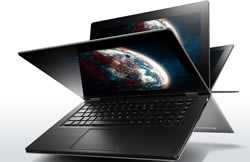Difference between Lenovo IdeaPad Yoga 13 and Asus Padfone Infinity
Key difference: The unique aspect of Lenovo IdeaPad Yoga 13 is that it is a convertible laptop with multi-mode 360 deg Flip design. This allows the device to take up four design modes. This includes Laptop Mode, Tablet Mode, Tent Mode and finally, Stand Mode. The Lenovo IdeaPad Yoga 13 features a 13.3 inch HD+IPS capacitive multitouch display and weighs 1.54 kg (3.4 lbs). It is available in various models, powered either by 3rd generation Intel Core i7/ i5 / i3. The models would come with either a 4 GB DDR3 RAM or 8 GB. The Asus Padfone Infinity smartphone is a slick 5-inch full HD 1920x1080, Super IPS+ with Capacitive Multi touch panel and provides approximately 441 ppi density. The device is a bar phone, with curved corners giving it a similar look to the ‘iPhone’ and ‘HTC One’. The Asus Padfone Infinity Dock is basically the 10-inch tablet shell that allows users to dock their phone into the tablet by sliding it into a slick slot on the back.

Lenovo Group Limited is a Chinese multinational with its operational headquarters in Morrisville, North Carolina. The company provides computer hardware and electronics, including personal computers, tablet computers, mobile phones, workstations, servers, electronic storage devices, IT management software and smart televisions. Among other things, the company is especially known for its computers, especially the ThinkPad and IdeaPad line of notebook computers.
Lenovo IdeaPad Yoga 13 is yet another offering by Lenovo under its IdeaPad series. However, the unique aspect of the device is that it is a convertible laptop with multi-mode 360 deg Flip design. This allows the device to take up four design modes. This includes Laptop Mode, Tablet Mode, Tent Mode and finally, Stand Mode. This is managed by using two double sided hinges. This feature gives the device versatility and allowing the user to use the device as either a laptop or a tablet. Hence, the device is effectively two-in-one, a tablet and a laptop.
The Lenovo IdeaPad Yoga 13 features a 13.3 inch HD+IPS capacitive multitouch display and weighs 1.54 kg (3.4 lbs). It is available in various models, powered by 3rd generation Intel Core i7-3537U/ 3rd generation Intel Core i7-3517U/ 3rd generation Intel Core i5-3317U/ 3rd generation Intel Core i3-3217U. The models would come with either a 4 GB DDR3 RAM or 8 GB. The Lenovo IdeaPad Yoga 13 runs on Windows 8 Pro 64 or Windows 8 64 depending on the variant models.
The four different configurations on the IdeaPad Yoga does make the device seem new, fresh and unique, however in order to get to the tablet mode, the screen folds back, which leaves the keyboard exposed on the back of the tablet. This makes holding the tablet, a little awkward; however, the keyboard does get automatically disabled. In addition, the device is quite thin and light, which makes the device quite operable. Hence the exposed keyboard is not necessarily a deal breaker.
 Asus has announced its latest phone and tablet in the Padfone series, knighted the Asus Padfone Infinity. The original Asus Padfone did not reach the Western Shores but the company states that the Padfone Infinity is set for world-wide launch in the second quarter of 2013. Similar to the original Padfone, the Padfone Infinity is available just as smartphone or along with a tablet dock that allows seamless transition between phone and tablet needs. The Padfone Infinity is a pretty intriguing concept that allows the phone to dock on the tablet, which powers the tablet and transfers all the data on the tablet for use. However, without the phone the tablet is just a shell without any ‘brain’ of its own. The phone/tablet is set to provide serious competition to rivals Sony Xperia Z Tab, iPad 4 and Samsung Galaxy Tab. Let’s cover its features separately.
Asus has announced its latest phone and tablet in the Padfone series, knighted the Asus Padfone Infinity. The original Asus Padfone did not reach the Western Shores but the company states that the Padfone Infinity is set for world-wide launch in the second quarter of 2013. Similar to the original Padfone, the Padfone Infinity is available just as smartphone or along with a tablet dock that allows seamless transition between phone and tablet needs. The Padfone Infinity is a pretty intriguing concept that allows the phone to dock on the tablet, which powers the tablet and transfers all the data on the tablet for use. However, without the phone the tablet is just a shell without any ‘brain’ of its own. The phone/tablet is set to provide serious competition to rivals Sony Xperia Z Tab, iPad 4 and Samsung Galaxy Tab. Let’s cover its features separately.
The Asus Padfone Infinity smartphone is a slick 5-inch full HD 1920x1080, Super IPS+ with Capacitive Multi touch panel and provides approximately 441 ppi density, making the screen visibly sharp, crisp and clear. The device is a bar phone, with curved corners giving it a similar look to the ‘iPhone’ and ‘HTC One’. The phone has a sleek metallic chassis, with a silver brushed look on the back. The phone is powered by the latest 1.7GHz quad-core Krait Qualcomm Snapdragon 600, providing fast responsiveness from the device. It offers the latest Android v4.2 Jelly Bean. The phone has a 2GB RAM and is available with 32/64 GB of internal storage capacity. The phone houses a 13MP primary camera and a 2MP secondary camera, with HD recording capability. The massive battery power allows the phone to provide up to 19 hours of 3G talk time. The company also introduced a bunch of new features such as Asus Echo, SuperNote, ASUS Story, Instant Dictionary and two years’ free Cloud Storage with 50GB ASUS WebStorage. The Asus Echo is the newest personal assistant, similar to Siri that allows the user to activate a number of features (search contacts, make calls, pick up incoming calls, activate the camera shutter for self-portraits, set alarms, change settings, etc) on the phone using voice commands. The new SuperNote supports real-time handwriting to text conversion and is sensitive enough to accurately translate from handwriting to text. Asus Story allows users to create albums and story lines, while Instant Dictionary allows users to translate words, phrases and sentences in emails, web pages or apps.
The Asus Padfone Infinity Dock is basically the tablet shell that allows users to dock their phone into the tablet by sliding it into a slick slot on the back. The slot comes with rubber gromits that ensures that the phone locks into place and does not slide out and fall. When the phone is docked on the tablet, the tablet and the phone synchronize automatically and the apps that were on the screen of the phone automatically re-sizes itself and pops up on the tablet screen. The tablet sports a 10.1 Full HD 1920x1080, Super IPS+ with Capacitive Multi touch panel, similar to the phone, providing a clear and detailed picture on the tablet. The screen on both, the phone and the tablet, have a Corning Gorilla Glass covering. The tablet does not have a processor or anything such hardware on it. It does offer a few advantages to the phone. The tablet houses a 1MP front camera for video calls. The tablet is also capable to output 1080 Full HD video via Micro-USB compatible MyDP interface. The device also has a dialer and is able to accept and make phone calls and send text messages. The phone and the tablet have speakers have the ASUS Audio Wizard audio enhancement providing rich audio experience. The battery as a massive 5000 mAh Li-Polymer, that enhances the battery power of the phone allowing up to 40 hours of 3G talk time. The tablet also has the power to charge the phone three times with a full battery. The tablet starts charging the battery of the phone, when the phone is docked into the tablet.
The high-end phone/tablet hybrid comes with a high-end price of EUR 999 and should be around US$ 1300 when it finally reaches the States. The main purpose of such a hybrid is so that people can use one data plan and it eliminates the need for manually synchronizing the tablet to phone and vice-versa. The phone has also been criticized for the lack of the keyboard, which was one of the features available in the original Padfone. Will the phone be a massive success or failure will be seen when the phone finally becomes available world-wide.
The information for the detailed table about the two devices has been taken from the Lenovo website, the Asus website, and GSMArena.com.
|
|
Lenovo IdeaPad Yoga 13 |
Asus Padfone Infinity |
|
Launch Date |
October 2012 |
Expected Release Q2/2013 |
|
Company |
Lenovo |
Asus |
|
Size |
333.4 x 224.8 x 16.9 mm (13.1 x 8.9 x 0.67") |
Phone:143.5 x 72.8 x 8.9 mm Pad: 264.6 x 181.6 x 10.6 mm |
|
Display |
13.3" HD+IPS capacitive multitouch display (16:9 widescreen) |
Phone: 5-inches, Full HD 1920x1080, Super IPS+ with Capacitive Multi touch panel Pad: 10.1-inches, Full HD 1920x1080, Super IPS+ with Capacitive Multi touch panel |
|
Screen |
1600 x 900 pixels (~138 ppi pixel density) |
Phone: 1080 x 1920 pixels (~441 ppi pixel density) Pad: 1920x1080 pixels (~441 ppi pixel density) |
|
Protection |
- |
Corning Gorilla Glass on both the phone and the pad. |
|
Weight |
1.54 kg (3.4 lbs) |
Phone: 141 grams Pad: 530 grams |
|
2G Network |
- |
GSM 850 / 900 / 1800 / 1900 |
|
3G Network |
- |
HSDPA 900 / 2100 |
|
4G Network |
- |
LTE 800 / 1800 / 2600 / 2100 |
|
GUI |
Windows 8 |
Asus' UI |
|
CPU speed |
1.80 GHz - 3.10 GHz |
1.7GHz quad-core Krait Qualcomm Snapdragon 600 |
|
GPU |
Intel HD Graphics 4000 (integrated) |
Adreno 320 |
|
OS |
Windows 8 Pro 64/ Windows 8 64 |
Android v4.2 (Jelly Bean) |
|
Chipset |
3rd generation Intel Core i7-3537U 3rd generation Intel Core i7-3517U 3rd generation Intel Core i5-3317U 3rd generation Intel Core i3-3217U |
Qualcomm APQ8064T Snapdragon 600 |
|
RAM |
4GB / 8GB DDR3 |
2 GB |
|
SIM Size |
- |
nanoSIM |
|
Internal Memory |
128/256GB DDR (double data rate) SSD (solid state drive); HDD Interface: m-SATA II (SATA300); DMA Mode: Transfer Multiword DMA mode-2, Ultra-DMA Mode 6 |
32/64 GB |
|
Expandable Memory |
No |
N/A |
|
Sensors |
- |
G-Sensor, E-compass, Gyroscope, Proximity, Light Sensor |
|
Connectivity |
1 USB 2.0 port, 1 USB 3.0 port, Combo jack, HDMI, 2-in-1 card reader (SD/MMC) |
GPRS Class 10, EDGE Class 10, LTE, Bluetooth, Wi-Fi, USB, Wi-Fi hotspot. |
|
Data |
- |
GPRS, EDGE, WLAN, Bluetooth, NFC, USB, USB Host. |
|
Speed |
- |
DC-HSPA+, 42 Mbps; HSDPA, 21 Mbps; HSUPA, 5.76 Mbps; LTE, Cat3, 50 Mbps UL, 100 Mbps DL |
|
WLAN |
802.11 b/g/n wireless |
Wi-Fi 802.11 a/ac/b/g/n, Wi-Fi Direct, dual-band, Wi-Fi hotspot |
|
Bluetooth |
Bluetooth 4.0 |
Bluetooth v4.0 with A2DP |
|
USB |
USB 2.0 and USB 3.0 |
microUSB v2.0 (MHL), USB Host |
|
Primary Camera |
1.0MP 720p HD integrated webcam |
13 MP, 4128 x 3096 pixels, autofocus camera |
|
Secondary Camera |
- |
Phone: 2 MP 1080p@30fps camera Pad: 1MP front camera |
|
Video |
- |
1080p@30fps |
|
Camera Features |
- |
LED flash Geo-tagging Touch focus Face detection |
|
Sound Enhancement |
Integrated stereo speakers |
ASUS Audio Wizard ASUS Sonicmaster |
|
Audio supported formats |
Dependent on media player |
MP3/3GP/AAC/AAC+ |
|
Video supported formats |
Dependent on media player |
MP4/H.264/H.263 player |
|
Battery Capacity |
4-cell Li-Polymer battery |
Phone: 2400 mAh Li-Polymer Pad: 5000 mAh Li-Polymer |
|
Stand-by / Battery Life |
8 hours |
Phone: 3G: 19 hours Pad: 3G: 40 hours |
|
Talk time |
- |
Phone: 3G: 410 hours Pad: 3G: 920 hours |
|
Available Colors |
Silver Gray, Clementine Orange |
Titanium Gray, Champagne Gold, Hot Pink |
|
Messaging |
No |
SMS(threaded view), MMS, Email, Push Email, IM |
|
Browser |
HTML - Default Internet Explorer |
HTML5 |
|
Radio |
No |
FM radio |
|
GPS |
No |
A-GPS & GLONASS |
|
Java |
No |
Yes, via Java MIDP emulator |
|
Additional Features |
|
|
Image Courtesy: lenovo.com, asus.com









Add new comment